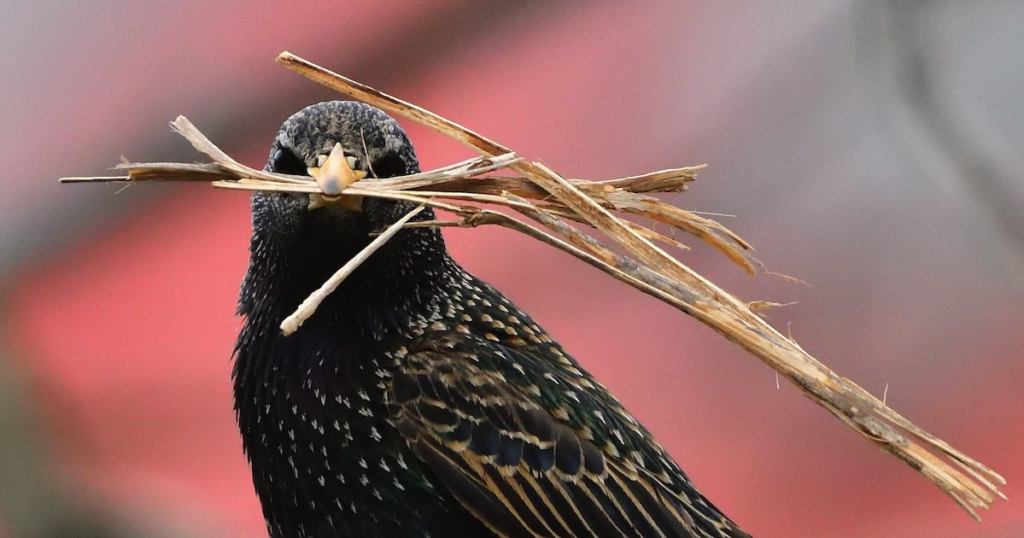As we cycle through the seasons each year, so changes the breeding calendar. Some birds nest in the cold, dark winter, while others await the last hot rays of summer. Hopefully your foray into atlasing has helped tune you into the seasonal changes that birds use to tell them when it’s time to start nesting. Journey through a year of atlasing.

European Starlings nest early and often, usually having several broods each year. Photo by Adam Zahm/Macaulay Library.
Great Horned Owls are our earliest reliable nester, starting their courtship duets as early as November and beginning nesting in January. In the first few months of the year, other large raptors like Bald Eagles and Common Ravens initiate nesting, followed by the smaller corvids and owls. Urban birds that can nest near warm heating vents and other artificially warm locales also start nesting while there is still snow on the ground, birds such as House Sparrows, European Starlings, and Rock Pigeons.
Most of our forest residents, like chickadees, titmice, nuthatches, and some of the woodpeckers, start nesting in April and can survive early cold snaps by holing up in their cavity nests. At the same time, our forests and fields are enriched by the drumming of Ruffed Grouse, the peenting and twittering aerial displays of American Woodcock, and the whirring of male Spruce Grouse as they perform their flutter-jumps to attract mates.
Things start to heat up in late April and the first part of May, literally. The soil thaws, rivers come to life, and the leaves start unfurling. Some of the larger, hardier waterbirds start nesting as soon as the waters thaw, such as swans, Canada Goose, Mallard, Great Blue Heron, and Sandhill Crane. Coastal areas of Long Island warm up sooner than the rest of the state, and early returning birds take advantage, such as American Oystercatcher and Clapper Rail. Our trusty harbinger of spring, the Red-winged Blackbird, can be heard from every patch of reeds in the state by now.

Great Blue Herons start building their nests before the leaves are back on the trees. Photo by Graham Deese/Macaulay Library.
As spring advances, insects begin to emerge, which means there is more food available to support returning migrants. By mid-May, the migrant hawks, swallows, wrens, sparrows, and flycatchers have returned, and warbler migration hits its peak. By the end of the month, rails, nightjars, and thrushes fill out the avian soundscape. Males arrive first to stake a claim to the best territories so that when females return a week or two later they can quickly scout out a good place to build a nest. They get down to business gathering nesting material right away.
In the first couple weeks of June there is a lot of bird song filling the air, but it slowly diminishes as they lay eggs and start incubating. This is followed by a lull in the breeding season, kind of a calm before the storm, that breaks in late June and early July. There is a rush of chatter, not of bird song, but of call notes between pairs communicating to each other as they frantically try to find enough food to feed their young. We as atlasers feel this rush, too. It’s a glorious time to be out watching bird behaviors. Birds are so busy collecting food to quiet their incessantly begging young, that they pay little notice to us interlopers.

During an invasion year, both Red and White-winged Crossbills may attempt to nest twice, once in Jan/Feb and again in Jul/Aug. Adult female White-winged Crossbill by Brad Vissia/Macaulay Library.
And then it’s suddenly done. We are left with a feeling of loss as we watch the birds we’ve gotten to know so well disperse or congregate in large flocks. At the same time, some birds are just getting started! Just as the warblers waited until there were insects to return north, and just as the hawks timed their nesting to coincide with maximum fledgling songbirds to feed their young, other species were waiting for conditions to be right for raising their young. Cedar Waxwings were waiting for bountiful summer fruits while American Goldfinches were waiting for thistle, aster, and sunflower seeds to be available. Red and White-winged Crossbills, if they have dropped down for a visit from Canada, wait to take advantage of soft, fresh cones on the trees. Birds with second and third broods can also be seen feeding young into late summer.
Fall is pretty quiet for atlasers. Birds migrate south, the leaves change color, and mammals get ready to hibernate. But one bird, the Barn Owl, has been known to nest in every month of the year!
Before you know it, the days shorten, the first snow falls, and Great Horned Owls delight us with their evening duets and it starts all over again. Now that you have witnessed a full breeding calendar firsthand, you can enjoy atlasing in the new year with an even deeper appreciation.
Refer to the Breeding Guideline Bar Chart to learn when each species breeds in NY.
[This article first appeared in New York Birders, a publication of the New York State Ornithological Association.]


